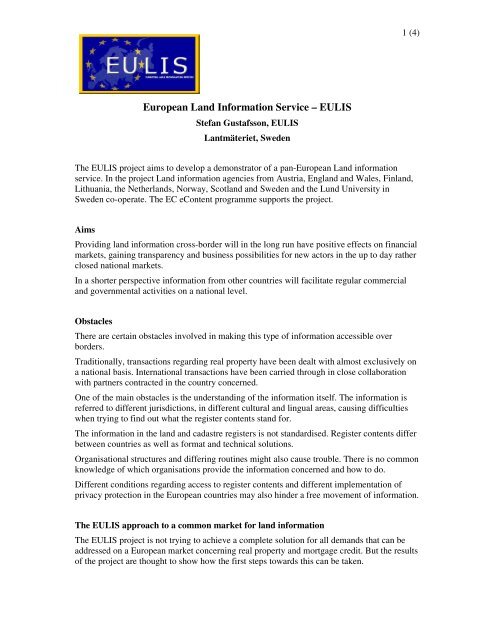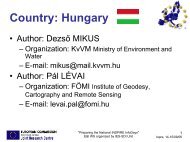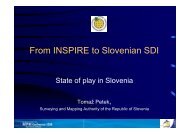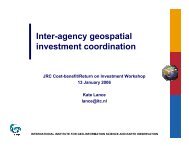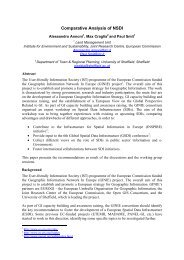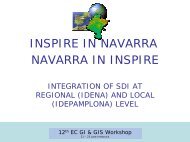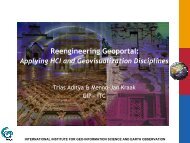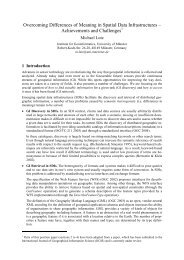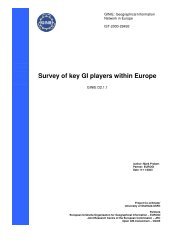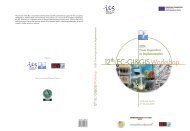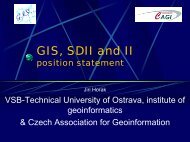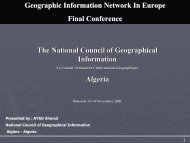European Land Information Service – EULIS - EC GI & GIS Portal
European Land Information Service – EULIS - EC GI & GIS Portal
European Land Information Service – EULIS - EC GI & GIS Portal
Create successful ePaper yourself
Turn your PDF publications into a flip-book with our unique Google optimized e-Paper software.
<strong>European</strong> <strong>Land</strong> <strong>Information</strong> <strong>Service</strong> <strong>–</strong> <strong>EULIS</strong><br />
Stefan Gustafsson, <strong>EULIS</strong><br />
Lantmäteriet, Sweden<br />
The <strong>EULIS</strong> project aims to develop a demonstrator of a pan-<strong>European</strong> <strong>Land</strong> information<br />
service. In the project <strong>Land</strong> information agencies from Austria, England and Wales, Finland,<br />
Lithuania, the Netherlands, Norway, Scotland and Sweden and the Lund University in<br />
Sweden co-operate. The <strong>EC</strong> eContent programme supports the project.<br />
Aims<br />
1 (4)<br />
Providing land information cross-border will in the long run have positive effects on financial<br />
markets, gaining transparency and business possibilities for new actors in the up to day rather<br />
closed national markets.<br />
In a shorter perspective information from other countries will facilitate regular commercial<br />
and governmental activities on a national level.<br />
Obstacles<br />
There are certain obstacles involved in making this type of information accessible over<br />
borders.<br />
Traditionally, transactions regarding real property have been dealt with almost exclusively on<br />
a national basis. International transactions have been carried through in close collaboration<br />
with partners contracted in the country concerned.<br />
One of the main obstacles is the understanding of the information itself. The information is<br />
referred to different jurisdictions, in different cultural and lingual areas, causing difficulties<br />
when trying to find out what the register contents stand for.<br />
The information in the land and cadastre registers is not standardised. Register contents differ<br />
between countries as well as format and technical solutions.<br />
Organisational structures and differing routines might also cause trouble. There is no common<br />
knowledge of which organisations provide the information concerned and how to do.<br />
Different conditions regarding access to register contents and different implementation of<br />
privacy protection in the <strong>European</strong> countries may also hinder a free movement of information.<br />
The <strong>EULIS</strong> approach to a common market for land information<br />
The <strong>EULIS</strong> project is not trying to achieve a complete solution for all demands that can be<br />
addressed on a <strong>European</strong> market concerning real property and mortgage credit. But the results<br />
of the project are thought to show how the first steps towards this can be taken.
The demonstrator will conceptually consist of two parts, one common part explaining the<br />
information and one part presenting the information from the national registers.<br />
By combining land information from different providers, completed with explanations of the<br />
information content, and make it accessible through reliable current national routines, i.e.<br />
single sign on, the information retrieval will be simple from a users point of view.<br />
Understanding the information<br />
2 (4)<br />
Some of the main obstacles for cross-border transactions concerning real property are the<br />
divergences in the legal context in the <strong>European</strong> countries. Basically similar, concepts and<br />
especially routines have developed into a wide range of different procedures when property is<br />
to be transferred, mortgaged, executed and taxed.<br />
Therefore, to facilitate cross-border actions, it is necessary to provide information on the legal<br />
system itself, as well as routines concerning the most common transactions.<br />
There are several current initiatives concerning standards for description of land and property<br />
information, as well as the legal framework that rules routines and activities in the area. The<br />
<strong>EULIS</strong> project will not, nor can, wait for the results from these initiatives or disregard future<br />
results of the work. What we are trying to do meanwhile, and in the project, is to describe the<br />
information in the registers, what the information stands for and the most common<br />
transactions concerning the information. The way we do this is to provide core information<br />
for all participating countries in a standardised and unified way in the service.<br />
Naturally, a complete service should provide all information in the user’s native language. To<br />
achieve this is however not only a question of translation, but furthermore a question of<br />
explanation. The conceptual meaning of a word very often differs between jurisdictions. To<br />
exclude linguistic facilities would make the service difficult to adopt for coming users. In<br />
<strong>EULIS</strong> we have not gone for a complete solution, as it should demand far too much resources<br />
compared with the project budget. In the project we have chosen to make a general wordlist in<br />
English linked to all participants’ languages, explaining the most common concepts dealing<br />
with real property and property transactions. The register outputs are also translated to<br />
English with the exception of the register information itself.<br />
Technical solution<br />
The technology used in the demonstrator is a portal providing core information and<br />
connections to register services from the national systems. The portal technique is used not<br />
only to facilitate the implementation, but also to make it possible to start and join the service<br />
as easy as possible for additional national information providers.
The portal architecture enables<br />
Fig. 1 The <strong>EULIS</strong> <strong>Portal</strong><br />
− A slimmed <strong>EULIS</strong> system with most of the critical functionality in the national systems<br />
− Reasonable maintenance costs for a possible permanent service<br />
− Different levels of ambition when connecting to the service. The easiest solution is to<br />
present the current HTML interface from the national service. This can later on be<br />
developed further in several steps.<br />
− An adaptable connection to the service for future partners<br />
− Development in smaller steps, making it easier to take care of user demands as they<br />
develop.<br />
The functionality of the service can be described as follows:<br />
Step User action System action<br />
1 The user logs in to a<br />
national service<br />
where he/she<br />
already is a licensed<br />
user<br />
2 The user chooses<br />
the <strong>EULIS</strong> service<br />
3 The user chooses<br />
origin of<br />
Authentication and authorisation of the user is made in<br />
the national system. The only need for accessing the<br />
<strong>EULIS</strong> service is that the user is a licensed user in a<br />
national system taking part in the service.<br />
Logon to the <strong>EULIS</strong> portal. In the portal, the national<br />
system is considered as a valid user. <strong>Information</strong> about<br />
the transaction (identification of the user) is included for<br />
invoice purposes. Access to meta data about registers,<br />
legislation and land transactions is provided by the<br />
portal.<br />
Logon to the national system concerned. The <strong>EULIS</strong><br />
portal is a valid user in the different national systems.<br />
3 (4)
information wanted<br />
4 The user collects the<br />
information wanted<br />
5 The user is invoiced<br />
by the national<br />
system.<br />
User involvement<br />
The national system presents the information through the<br />
portal to the user and returns information for invoice.<br />
The portal has functionality to keep track of transactions<br />
so that payment goes to the right information provider.<br />
4 (4)<br />
Recently the first prototype of the demonstrator has been presented to selected representatives<br />
from different user categories in the participating countries. Their opinions will continuously<br />
be collected and ideas and proposals from them will influence the coming development of the<br />
demonstrator. From the first contacts we can say that making the service visible tends to<br />
increase the interest for this type of service on a, up today, rather unworked market.<br />
What will happen after project’s finish?<br />
The project is planned to end in June 2004, after a 6 months evaluation of the demonstrator.<br />
The demonstrator will not be a completed system that can be put in production on a regular<br />
basis. The project will however describe the additional development such a permanent<br />
solution will demand.<br />
The current <strong>EULIS</strong> organisations are all by now focused on making the <strong>EULIS</strong> service a<br />
reality after the project ends. In this future service also other land information agencies in<br />
Europe are invited to take part. The project has therefore invited all land agencies in the EU<br />
member and candidate countries to follow the project and to go into deeper discussions on the<br />
future.


